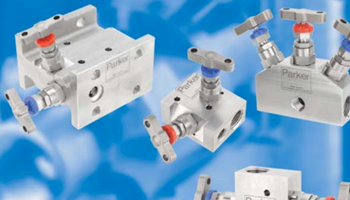

Parker Hannifin offers the most comprehensive range of two valve block and bleed manifolds to suit all types of applications. As a trusted UK distributor, Fluid Controls can provide the complete ‘H’ Series range to you. In this blog, we outline some of the popular different models and their features.
Double block and bleed valves replace traditional techniques employed by pipeline engineers to generate a double block and bleed configuration in the pipeline. Two block valves and a bleed valve are installed as a unit, or manifold, for positive isolation. Used for critical process service, double block and bleed valves are for ideal for high pressure systems or hazardous fluid processes. Applications using these types of valves include instrument drain, chemical seal isolation and gauge isolation.
Designed to reduce installation costs and improve safety performance, the consolidation of valves into one unit provides you with a combination of instrument isolation together with bleed/vent and test facilities. Double block and bleed valves valves do the work of three separate valves – two isolations and one drain – which means they require less space and are more lightweight.
In addition to manufacturing manifolds, Parker also produce a comprehensive range of single and twin ferrule high integrity tube fittings manufactured in a variety of materials. Integrating instrument manifolds and tube fittings means unique connection combinations. These are designed to eliminate site assembled threaded connectors, ingress of debris and contamination from thread sealant materials that can result in instrument failure and ultimately costly replacements and downtime.
Parker ‘H’ Series two valve manifolds feature a standard manifold globe style bonnet design for safe, reliable and repeatable performance. Retrofit design options include T bar handle locking, anti tamper spindle, standard and lockable handwheels, and panel mounting.
Within the ‘H’ Series range, Fluid Controls can supply remote mount static pressure manifolds, which combine valves into one block to perform isolation, bleed and calibration of pressure transmitters, gauges and switches. Or direct mount static pressure manifolds for direct mounting to process measurement pressure transmitters. Standard functions include isolation, test, bleed and calibration.
We can also provide double block and bleed instrument manifolds, for dual isolating and bleed purposes (ideal for limited space and panel installations); high pressure two valve manifolds, designed for more aggressive applications and for operation up to 10,000 psig (689 barg); and miniature static pressure manifolds for installation inside control panels or any size limited construction. The latter provide size, weight and cost savings whilst at the same time meeting industry standard pressure rating performance of 6,000psig (414 barg).
Finally, Parker’s flanged connected static pressure manifolds are designed for fast and efficient installation and removal of pressure measurement instruments. Single kidney flange arrangements are provided with optional inlet connections for total installation flexibility and the redundant connection can also be used for purge operations. While the dual flanged model enables users to mount two pressure measuring devices connected to a common inlet, with redundant cross-hole connections for process purging.
For more information about all our Parker ‘H’ Series Two Valve Manifolds, speak to a Fluid Controls adviser today by calling +44 (0) 118 970 2060 or email fluid@fluidcontrols.co.uk.